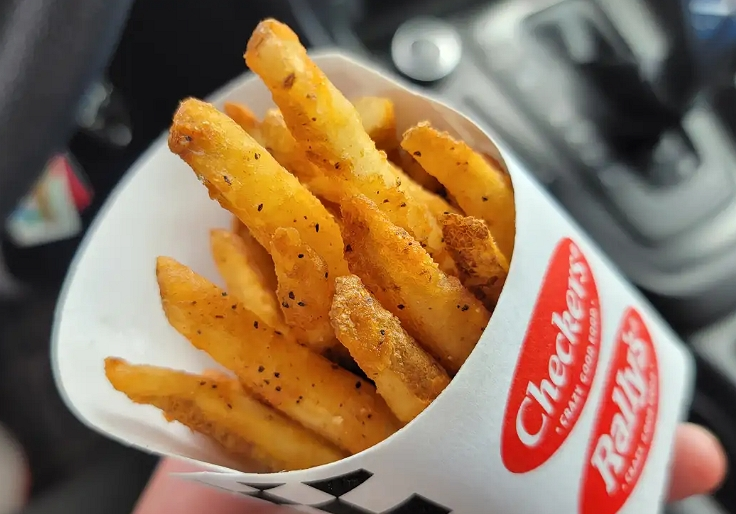Can Perfect Fries Fix A Bad Burger?
In my mid-teens, a Checkers popped up in town. It took up residence in the old Hot ‘n Now building, which had been in an unctuous silence for years.
With its neon lights and vaguely “track” theme, Checkers became popular among Halo sessions. And if we needed to escape a backyard after hitting a basketball over the house and onto the neighbour’s car, the triple-bacon cheeseburger haven was just a few streets away.
But some things are best seen with rose-coloured taste buds. I’ve tried a few times to recapture the magic of those early visits to Checkers (also known as Rally in other parts of the country), only to be struck by an entirely different kind of spell.
More recent menus, such as the Bacon Brewhouse Mother Cruncher and the Triple Smoky BBQ Bacon Buford, have focused on pork with varying degrees of success. Only one product has remained consistently excellent: the famous seasoned fries.

We love In-N-Out Burger. We talk about it on the radio. We address its political donations. We oppose those who speak ill of it.
On Highway 5, we drive past dozens of other fast food restaurants to eat at the Kettleman City outpost, even when it means standing in a 30-minute line. But as much as we love the sinner, we hate the sin, and In-N-Out’s original sin is its fries.
Problems With French Fries
The perfect fries are soft and crispy, with millions of microbubbles forming an unbreakable golden crust. Poorly cooked fries are smooth, greasy or mushy and often too dark.
All these problems result from improper handling of starch and sugar when exposed to high temperatures.
Start by rinsing the potatoes and coating them with a light layer of cornstarch before frying them twice for perfect results.
Rinsing The Fries
When I want chips, especially homemade chips, I want them golden and beautiful. That’s why the rinsing step is essential.
We know that potatoes are rich in starch (more on that in a moment) but also in natural sugars. Starches are composed of chains of simple sugars.
When we cut potatoes into sticks, we release some of these sugars on the surface of the potato strips. If we fried them without rinsing them, the outer sugars would caramelize in the boiling oil and burn before the inner starches could cook adequately, resulting in brown, sour-tasting, unattractive potato chips.
A half-hour soak in cold water, stirring occasionally, will remove the surface sugars, giving us time to properly cook the inside of the potatoes before the outside starts to burn.
Searching The Fried Potatoes
Now that we understand how starch acts in fried potatoes, we can understand why to starch the potatoes.
When you drain the rinsing water from potato sticks, you will notice that some potato starch settles to the bottom of the bowl.
The rinsing of the sugars has also removed a good deal of surface starch, and as we have already mentioned, surface starch is necessary for a crisp and fluffy finished product.
To get around this problem, we add cornstarch to the chips, which essentially replaces the starch in the freshly washed potatoes and forms a crispy film that will be hydrated by the steam escaping from the potatoes.
In this way, we have
- Eliminated surface sugars.
- Maintained (or even improved) the crispy exterior potential of the chips.
Frying Safety
Following the manufacturer’s instructions if you have a deep fryer at home. If you fry on the stove, as we do, be careful not to overfill the pan with oil.
When you add fries, the fries take up space, causing the oil level to rise, and the steam bubbles produced by the fries make it grow even higher.
Too much oil in the pan will increase over the edges of the pan and descend toward the stove flame, creating a fireball in your kitchen.
Another step that can be helpful is to make sure the chips look dry and starchy on the outside. After rinsing them, the chips should be dried and allowed to rest after sprinkling starch so that a starchy crust forms. This also removes excess surface water and prevents bubbles from forming.
Another step that can be helpful is to make sure that the chips have developed a good, dry, starchy exterior.
After rinsing them, the chips should be dried and allowed to rest after sprinkling them with starch so that a starch crust forms. This also removes excess surface water and prevents bubbles from forming.
Finally, if you are concerned, use less oil and fry in small batches. Filling the pan one-third full of oil will maintain a safe level, but you must fry fewer chips at a time.
Latest Posts Of Checkers & Rally – Updated Information
Must Check: Win a Free Sandwich by taking the Checkers & Rally’s Survey at GuestObsessed.Com.
- YourKFC.Co.Uk | KFC Listens | KFC Great Britain Survey
- Checkers & Rally’s Careers
- Checkers Delivery Locations (Latest One)
- Mushroom Swiss Burger Joins Checkers & Rally’s $5 Meal Deal For A Limited Time
- Checkers & Rally’s New “Rule the Drive-Thru” Game Show Is Here
- Can Perfect Fries Fix A Bad Burger?